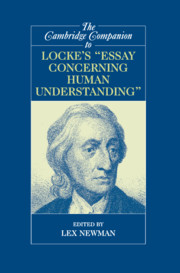Book contents
- Frontmatter
- Introduction
- 1 The Intellectual Setting and Aims of the Essay
- 2 Locke’s Polemic against Nativism
- 3 The Taxonomy of Ideas in Locke’s Essay
- 4 Locke’s Distinctions between Primary and Secondary Qualities
- 5 Power in Locke’s Essay
- 6 Locke on Substance
- 7 Locke on Ideas of Identity and Diversity
- 8 Locke on Ideas and Representation
- 9 Locke on Essences and Classification
- 10 Language, Meaning, and Mind in Locke’s Essay
- 11 Locke on Knowledge
- 12 Locke’s Ontology
- 13 The Moral Epistemology of Locke’s Essay
- 14 Locke on Judgment
- 15 Locke on Faith and Reason
- Bibliography
- Index of Names and Subjects
- Index of Passages Cited
7 - Locke on Ideas of Identity and Diversity
Published online by Cambridge University Press: 28 July 2007
- Frontmatter
- Introduction
- 1 The Intellectual Setting and Aims of the Essay
- 2 Locke’s Polemic against Nativism
- 3 The Taxonomy of Ideas in Locke’s Essay
- 4 Locke’s Distinctions between Primary and Secondary Qualities
- 5 Power in Locke’s Essay
- 6 Locke on Substance
- 7 Locke on Ideas of Identity and Diversity
- 8 Locke on Ideas and Representation
- 9 Locke on Essences and Classification
- 10 Language, Meaning, and Mind in Locke’s Essay
- 11 Locke on Knowledge
- 12 Locke’s Ontology
- 13 The Moral Epistemology of Locke’s Essay
- 14 Locke on Judgment
- 15 Locke on Faith and Reason
- Bibliography
- Index of Names and Subjects
- Index of Passages Cited
Summary
INTRODUCTION
Identity is a relation: it is the relation that each thing bears to itself. It is not the only relation that a thing can bear to itself. You can point at yourself, for instance. But identity is the only relation that each and every thing necessarily bears to itself and that no thing could bear to anything distinct from itself. By contrast, some things don't point at all, much less point at themselves, and sometimes you point at things other than yourself. For any relation, there are criteria that objects must meet if one is to bear the relation to the other: you are pointing at yourself, for instance, only if your finger is directed toward your body. Locke's Scholastic and Cartesian predecessors used the term “principium individuationis,” or the principle of individuation, to refer to the criterion that two things meet just in case they are, indeed, two things and not one. The flip side of the principle of individuation is what we might call the principle of identity, a criterion that two things meet just in case they are not two things at all but are, in fact, one. Imagine, for instance, that you are looking at a picture, taken some years ago, of a baby, and you are wondering if it is a picture of you. A specification of the principle of identity of persons would be a specification of a rule, or principle, that would be met by you and the baby in the picture just in case you are the baby in the picture.
- Type
- Chapter
- Information
- Publisher: Cambridge University PressPrint publication year: 2007
- 9
- Cited by



